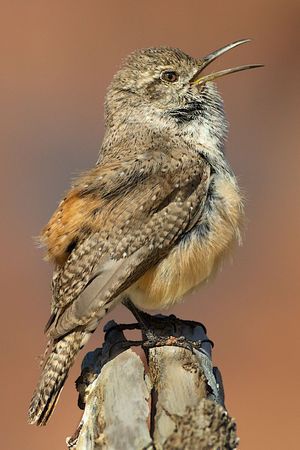Some information may be outdated.
Christmas is in the air, and unfortunately for many species, so is climate change. This holiday season, the public is invited to bundle up, step outside and take action on behalf of potentially threatened birds in the Moab area.
On Saturday, Dec. 17, experienced bird watchers and newcomers alike can participate in the longest running citizen science program in the world: the Christmas Bird Count. The count is one of two annual bird surveys that cover the entire United States and its territories, as well as southern Canada. This year will be the 117th Audubon Christmas Bird Count, and the 32nd that the Moab Bird Club has coordinated.
Marian Eason coordinates activities for the Moab Bird Club, and has been involved with the organization for more than 20 years. She says that volunteer citizen scientists will be out in full force, ranging through diverse habitats as they tally birds for what she considers a vital endeavor.
The Moab count circle includes parts of the Moab Valley, Castle Valley, Spanish Valley and stretches of the Colorado River. Eason explains that the numbers collected will be added to a giant database, which enables scientists to have a better understanding of early winter bird populations and changes that might occur.
There is a method to the madness and a wide range of volunteers to make the count happen. Although the Moab Bird Club started in 1984 with only 12 volunteers, it now has come to expect between 45 and 50 participants. Last year, it totaled 59 bird counters, also known as “birders,” and 73 species of birds.
Marcy Hafner organizes and compiles information for the count with the Moab Bird Club. Her passion for bird watching began over two decades ago as well, and she is eager to recruit.
“The more people we get to participate, the more we know. You don’t need to be knowledgeable,” Hafner says. “If you want to learn, we are here for that too.”
Eason says the Audubon Society hopes to engage citizens in collecting this important information, encourage them to take action on behalf of wildlife and their habitat, and foster a renewed effort on behalf of conservation.
“Data collected is also becoming more relevant as scientists determine what impacts climate change has on bird populations, and they will use it to help guide conservation actions,” she says.
In 2014, the Audubon Society issued a “comprehensive, first-of-its kind study that predicts how climate change could affect the ranges of 588 North American birds.” The Climate Change Report states, “Of the 588 North American bird species Audubon studied, more than half are likely to be in trouble. Our models indicate that 314 species will lose more than 50 percent of their current climatic range by 2080.”
The Christmas Bird Count has grown to include counts from above the Arctic Circle to the waters of Drake Passage, below the southern tip of Argentina. Volunteers in Antarctica have also contributed valuable data. The goal remains an increased understanding of the status of bird populations in Latin America, the Caribbean and U.S. territories.
Eason recalls last year’s Christmas Bird Count in Moab.
“Participants were blessed with a good variety of raptors, as well as overwintering song birds, ducks and geese. Rare birds [popped] up occasionally, delighting lucky observers,” she says.
A post-count potluck brunch will be held for participants at The Nature Conservancy office on Sunday, Dec. 18, at 10 a.m., where notes and numbers will be reviewed and presented.
Christmas Bird Count returns on Dec. 17
What: Christmas Bird Count
When: Saturday, Dec. 17
Where: Various locations around Moab
Cost: Free
Information: 435-259-6197; marcymoab@yahoo.com
To participate, contact Marcy Hafner at 435-259-6197, or email marcymoab@yahoo.com. For more information about Moab Bird Club meetings and activities, contact Nick or Marian Eason at 435-259-6447.
The more people we get to participate, the more we know. You don’t need to be knowledgeable.
Appreciate the coverage? Help keep local news alive.
Chip in to support the Moab Sun News.





